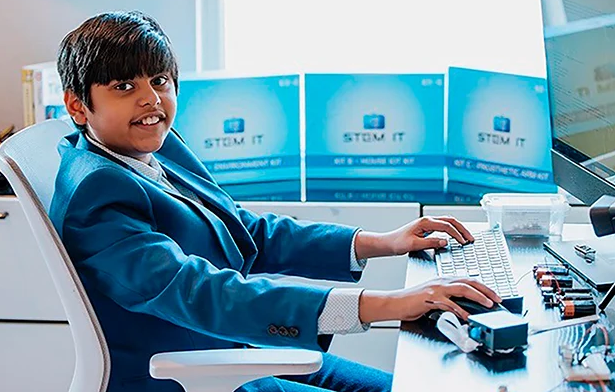
Age is merely a number; it’s the passion and vision that truly define one’s impact. These words ring true for the world’s young innovators, and among them stands 14-year-old Siddharth Nandyala, a genius shaking up the tech and healthcare industries.
His father, Mahesh Nandyala, is specializing in artificial intelligence, and his mother, Srilatha, introduced him to coding at the tender age of seven. His curiosity and passion for problem-solving led him to earn certifications in artificial intelligence and machine learning from Oracle and ARM, making him the world’s youngest AI-certified professional. But he didn’t stop there—he began working on an AI-driven solution to detect heart diseases, ultimately developing Circadian AI, a smartphone app that diagnoses heart disease—a breakthrough that could save millions of lives.
By simply recording heartbeats through a smartphone microphone, Circadian AI analyzes data and detects potential cardiac diseases—all in just seven seconds. No lab visits, no heavy machinery, and no costly clinical (临床的) tests—just a smartphone in good condition. The app has been successfully tested on 15,700 patients during its pilot trials (试验), proving its reliability with an accuracy rate of over 96%. “Its biggest strengths are accessibility and ease of use,” Siddharth explained at the Global AI Summit in Hyderabad.
The app’s potential is groundbreaking for rural areas with limited hospitals. During trials at India’s Government General Hospital, it demonstrated its ability to quickly and accurately identify heart conditions. “My goal is to bring this tool to communities with limited medical coverage, where rapid diagnoses can mean the difference between life and death, ” said Siddharth.
At just 14, Siddharth Nandyala has achieved what many take a lifetime to accomplish—and he’s only just getting started. With a keen mind, a firm determination, and a lasting passion for innovation, he is undoubtedly a name the world will continue to hear for years to come.
原创编写 版权所有 侵权必究! 每日更新 个性化阅读 英语飙升!
1.1. What led Siddharth to become the world’s youngest AI-certified professional?
A His parents’ jobs in the technology field.
B His early exposure to coding and passion.
C The educational environment around him.
D His participation in global AI summits.
解析:选B。细节理解题。文章第二段提到“His mother, Srilatha, introduced him to coding at the tender age of seven. His curiosity and passion for problem - solving led him to earn certifications in artificial intelligence and machine learning from Oracle and ARM, making him the world’s youngest AI - certified professional.”可知,他7岁接触编程,对解决问题的好奇和热情使他获得认证,成为最年轻的AI认证专业人士。A选项他父母在科技领域的工作,并非直接原因;B选项他很早开始对编程的接触以及他对编程的热爱,符合原文表述,是他成为世界最年轻AI认证专业人士的原因;C选项文中未提及相关教育环境内容,无法作为成为认证专业人士的直接因素;D选项他参加全球AI峰会在后面才提及,与获得认证无关。故选B。
2.2. How does Circadian AI detect heart diseases?
A By analyzing blood samples.
B By using expensive machines.
C By analyzing heart sounds.
D By requiring hospital lab tests.
解析:选C。细节理解题。根据第三段首句“By simply recording heartbeats through a smartphone microphone...”可知,该应用程序是通过手机麦克风记录心跳,进而分析心音数据来检测心脏病。所以该智能手机应用程序能在七秒内通过分析心音诊断心脏病。故选C。
3.3. Why did Siddharth focus on communities with limited medical coverage?
A These areas possess the highest rates of heart disease.
B He aimed to cut down the cost of smartphone production.
C Rural hospitals urgently requested his technology.
D Quick diagnoses are crucial for saving lives in these areas.
解析:选D。推理判断题。第四段引用Siddharth的话“where rapid diagnoses can mean the difference between life and death”可推知,他的目标是将这一工具带到医疗覆盖范围有限的社区,在那里,快速诊断可能意味着生死攸关。故选D。
4.4. What is the author’s attitude towards Siddharth’s future?
A Optimistic.
B Neutral.
C Negative.
D Uncaring.
解析:选A。推理判断题。结尾段强调“he is undoubtedly a name the world will continue to hear”,暗示其未来影响力将持续扩大,因此作者对他的未来持积极乐观的态度。故选A。